
Best Diesel Engine – 10 Most Reliable Units on the Market (2022 Update)
Before diesel engines became a must-have in heavy-duty trucks, they could be found in ships, submarines, and trains. Primarily used in the shipping industry, this engine was invented in the late 19th century by Rudolf Diesel. In the ‘70s, diesel became even more in-demand when gas prices escalated. In an attempt to combat rising fuel prices, vehicle makers started offering diesel engines as they claimed better fuel efficiency and higher miles per gallon.
Although diesel powerplants are not famous for their raw horsepower and torque like their gasoline counterparts, diesel engines are more durable, reliable, and fuel-efficient. Therefore, they tend to be the number one choice among car and truck owners.
Still, if a diesel motor isn’t adequately maintained or serviced, it can cause many problems. A poorly serviced diesel engine can potentially cause issues with the internal combustion system, gradually damaging the entire system.
Since diesel engines are pretty complex devices, whether or not to put them on your truck can be a pretty tough decision to make. These engines are packed with good and bad stuff, which impact their overall quality.
Not sure how to choose the best diesel engine for your truck? Here is the list of the 10 best diesel engines from top manufacturers in 2022.
Diesel vs. Gasoline Engine: Differences & Key Features
While both gas and diesel engines use internal combustion that converts chemical energy into mechanical energy, they have their differences.
One of the most significant differences between gasoline and diesel engines lies in the thermal efficiency, which directly impacts fuel economy. Since a diesel engine has about 20% more thermal efficiency than a gas engine, it is 20% more fuel-efficient than its counterpart. Therefore, it comes with lower operating costs.
Additionally, increased thermal efficiency translates to increased power and torque. Since they have higher torque, diesel engines are exceptionally convenient for hauling and carrying heavy loads.
Another benefit of choosing a diesel engine is its durability. Since it runs at slower revolutions per minute (RPM), diesel engines are less prone to wear and tear, which is not the case with gasoline engines.
What’s unique about gasoline engines is spark-fired combustion, meaning that the spark ignites the mixture of fuel and air, causing the engine to run. On the other hand, a diesel engine does not use a spark but relies on so-called compression combustion, where the air-fuel mixture explodes on its own.
How Does the Best Diesel Engine Work?
A four-stroke diesel engine works by repeating a cycle of four stages (strokes). During the cycle, the piston moves up and down twice.
#1 – Intake: Air is drawn into the cylinder through the open-air inlet valve as the piston moves down.
#2 – Compression: During the second phase, the inlet valve closes, the piston moves up, compresses the air mixture, and heats it. Then, fuel is injected through the central fuel injection valve into the hot gas, and it spontaneously ignites. As we mentioned earlier, a diesel engine does not require a sparking plug to make this happen.
#3 – Power: The air-fuel mixture ignites and burns, pushing the piston down and driving the crankshaft responsible for sending power to the wheels.
#4 – Exhaust: The outlet on the valve opens, letting out the exhaust gases that are pushed by the returning piston.
10 Best Diesel Engine Reviews (2022 Update)
Let’s meet the top 10 diesel engine players in 2022 and learn more about their specs, strengths, and weaknesses.
1. 6.6L Duramax LB7 – Overall Best Diesel Engine

The LB7 Duramax was originally introduced in 2001 as GM retired its 6.5L Detroit diesel. The Duramax was superior to the outdated Detroit and marked a revolutionary turning point for Chevrolet and GMC pickups in the diesel marketplace. The engine is unique compared to other Duramax units as it predates emissions regulations. As such, it’s praised for reliability and has been regarded as a particularly economical variation of the engine.
The LB7’s applications are in the GMC Sierra HD, GMC TopKick (medium-duty), Chevrolet Silverado HD, and Chevrolet Kodiak (medium-duty). As impressive as General Motors’ new engine platform appeared, the LB7 had issues with fuel injectors failing. Injector failures were so often that GM was forced to recall these units and replace them with an updated design. In addition, to give loyal customers a sense of reassurance, the warranty was extended to cover the new injectors for up to 200k miles.
Although the engine’s reliability was questioned due to aluminum heads, GM proved that Duramax could be light and incredibly reliable at the same time.
- Aspiration: Turbocharged and intercooler;
- Block material: Cast iron;
- Bore x Stroke: 87 x 4.13 inches;
- Cylinder head: Cast aluminum;
- Displacement: 6L;
- Engine oil capacity: 10 quarts with filter;
- Engine weight: 835 lbs.;
- Layout: V-8;
- Power: 300 hp;
- Torque: 520 lb./ft;
- Transmission: 5-Speed Auto Allison Transmission;
- Valvetrain: OHV with 4 valves per cylinder.
2. 6.7L Power Stroke – Best Ford Diesel Engine
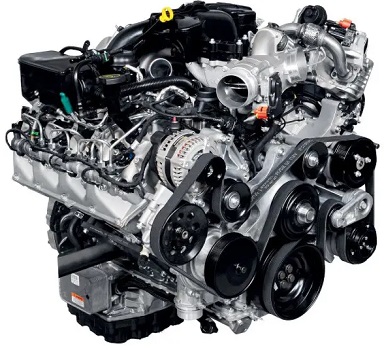
The 6.7L Power Stroke is an in-house built engine for the Ford Super Duty – the most reliable diesel truck engine. Ford designed, engineered, and produced its own diesel engine to maintain profitability and a competitive edge in the growing diesel segment. This’s the first Power Stroke not manufactured by a longtime partner, International Navistar.
For 2020 Ford presented the 3rd Generation 6.7L Power Stroke diesel, rated at a high peak of 1,050 lb./ft of torque and 475 hp. While the revised engine includes several significant changes, the most notable is its new piston design. The engine uses a steel piston with a relatively short overall height. Reduction of the piston’s height recompenses for the increased weight of steel, much heavier material than the previous aluminum design. The result is a piston that’s in weight to the pre-2020 piston. Still, it has improved strength/resilience and lower friction thanks to its smaller profile.
The 6.7L Power Stroke provides an impressive towing capability. In addition, its cutting-edge technology ensures quiet operation, increased fuel economy, and impeccable performance semi-truck owners seek.
- Aspiration: Single VGT turbocharger;
- Block material: Compacted Graphite Iron or CGI;
- Bore x Stroke: 89 x 4.25 inches;
- Cylinder head: Cast aluminum;
- Displacement: 7L;
- Engine oil capacity: 13 Quarts or 12.4 Liters;
- Engine weight: 1,100 lbs.;
- Layout: V-8;
- Power: 475 hp;
- Torque: 1,050 lb./ft;
- Transmission: TorqShift 10R140 Automatic 10-Speed Transmission;
- Valvetrain: Conventional pushrod OHV with 4 valves per cylinder.
3. 7.3L Power Stroke – Best Powerstroke Engine

The 7.3L Power Stroke diesel is engineered as the replacement for the aging 7.3L IDI. Even though the engines share the same displacements, the designs are entirely different. It’s a turbocharged, direct injection diesel engine manufactured by International Navistar. The “Power Stroke” trademark belongs to Ford, so you’ll only find the 7.3 “Power Stroke” in Ford applications.
The 7.3L Power Stroke turbodiesel is famous for its HEUI (hydraulic electric unit injector) injection system, which utilizes highly pressurized engine oil as a medium for making fuel pressure directly in the injector body, as opposed to a system needing a typical injector pump. Instead of an injection pump, the 7.3L Power Stroke uses a high-pressure oil pump (HPOP) and a low-pressure lift pump to produce fuel pressures up to 21,000 psi.
- Aspiration: Single turbocharger, Garrett GTP38 (wastegate);
- Block material: Cast iron block;
- Bore x Stroke: 11×4.18 inches;
- Cylinder head: Cast Iron/w 6 head bolts per cylinder;
- Displacement: 3L;
- Engine oil capacity: 15 Quarts /w filter or 14.2 Liters;
- Engine weight: 920 lbs.;
- Layout: V-8;
- Power: 275 hp;
- Torque: 525 lb./ft;
- Transmission: ZF S6-650 6-Speed Manual Transmission;
- Valvetrain: OHV (overhead valve) with 2 valves per cylinder.
4. 6.6L Duramax LP5 – Best Duramax Diesel Engine
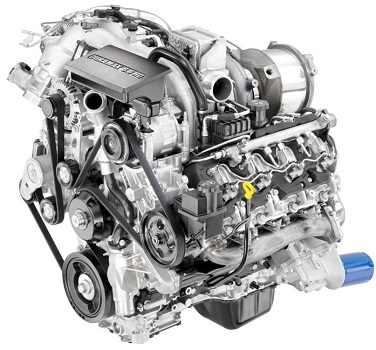
GM highly anticipated the reveal of the next-generation Duramax diesel, which was momentarily interrupted by inadvertently publishing details of the engine’s torque and horsepower figures through General Motors’ website. The Duramax L5P features many improvements and upgrades that produce 445 horsepower and 910 lb./ft of torque in addition to managing the rigorous conditions experienced under such loads.
Although the engine measures at 6.6L of displacement (using the identical cylinder bore and stroke-like previous generations), it’s not far from being characteristically classified as a new design. The Duramax L5P replaced the outgoing LML for the 2017 model year GMC Sierra HD pickups and Chevrolet Silverado.
The LP5 features an enhanced oiling circuit and a better lubrication system. This ensures a faster oil delivery and more pressure at the turbocharger. These additions promote lower engine temperatures, increasing overall reliability, durability, and capacity.
- Aspiration: Electronically controlled and actuated variable geometry turbocharger;
- Block material: Cast iron;
- Bore x Stroke: 05 x 3.89 inches;
- Cylinder head: Cast aluminum;
- Displacement: 6L;
- Engine oil capacity: 10qt/9.5L;
- Engine weight: 1,100 lbs.;
- Layout: V-8;
- Power: 445 hp;
- Torque: 910 lb./ft;
- Transmission: Allison 1000 6-speed Transmission;
- Valvetrain: OHV with 4 valves per cylinder.
5. Chrysler 3.0L EcoDiesel – Best Small Diesel Engine
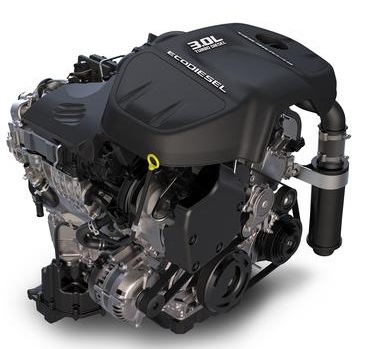
The 3.0L EcoDiesel was entranced in the 2014 Ram 1500 and Jeep Grand Cherokee, where it became the first factory-direct diesel engine solution in a 1/2 ton pickup in more than a decade. The 3.0L EcoDiesel is produced by VM Motori, an Italian manufacturer and current subsidiary of FCA, in Cento, Italy. Though the EcoDiesel remains available in the Ram 1500, it was retired in Jeep Grand Cherokee applications following the 2019 model.
From 2014 through 2019, this 4-cylinder diesel engine was rated at the peak of 240 horsepower and 420 lb./ft of torque. The EcoDiesel was revised for 2020, likely thanks to competition from General Motors and Ford Motor Company, which increased power by 20 horsepower and torque by 60 lb./ft in addition to enhancing the fuel economy ratings for both two- and four-wheel-drive models.
The 3.0 EcoDiesel features a Compacted Graphite Iron block, which reduces weight, delivering top-class NVH qualities, and superb strength. At the same time, the aluminum alloy cylinder reduces friction and helps lower NVH. In addition, engine durability is achieved through a forged steel crankshaft and connecting rods.
- Aspiration: Turbocharged and intercooler;
- Block material: CGI – Compacted Graphite Iron;
- Bore x Stroke: 27 x 6.30 inches;
- Cylinder head: Aluminum alloy;
- Displacement: 0L;
- Engine oil capacity: 2 Quarts or 7.8 Liters (Grand Cherokee);
- Engine weight: 505 lbs.;
- Layout: V-6;
- Power: 240 hp;
- Torque: 420 lb./ft;
- Transmission: Torque Flite 8HP75 8-Speed Automatic Transmission;
- Valvetrain: DOHC with 4 valves per cylinder.
6. 6.6l Duramax LBZ
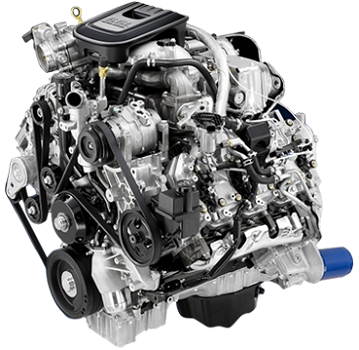
The LBZ boasts more aggressive engine tuning, yielding a substantial increase in horsepower and torque over its predecessor (LLY). This four-cylinder diesel engine produces 360 horsepower and 650 lb./ft of torque to the LLY’s 310 horsepower and 605 lb./ft. By mid-model year for ’07, the LBZ was efficiently replaced by the emissions compliant, diesel particulate filter equipped LMM.
The 6.6L Duramax LBZ’s applications included the GMC Sierra HD, GMC TopKick, Chevrolet Silverado HD, and Chevrolet Kodiak. In the aftermarket, the LBZ is extremely popular for its excellent performance potential, an abundance of support, and the fact that it’s the last model manufactured without a diesel particulate filter. Information released by GM at the introduction of the LBZ state that the engine has an increased piston pin diameter and thicker connecting rod section over previous generations in addition to an enhanced block casting.
The LBZ Duramax has always been a top choice for racing since it delivers easy power on a more durable platform. Additionally, it has much stronger block casting and rods that ensure easier and more productive truck tuning.
- Aspiration: Single turbocharger, Garrett GTP38 (wastegate);
- Block material: Cast iron;
- Bore x Stroke: 06×3.90 inches;
- Cylinder head: Cast aluminum;
- Displacement: 6L;
- Engine oil capacity: 10 Quarts With Filter;
- Engine weight: 835 lbs.;
- Layout: V-8;
- Power: 397 hp;
- Torque: 910 lb./ft;
- Transmission: 6-Speed Auto Allison 1000 Transmission;
- Valvetrain: OHV with 4 valves per cylinder.
7. Cummins 6.7L Engine for RAM

The 6.7L Cummins is the newest of the B-series engine lineup, introduced mid-model year in 2007. Replacement of the former 5.9L ISB was required due to stricter Federal emission standards and the need for a more competitive platform to permit future growth under growing industry constraints.
It’s the first Cummins to require a DPF (diesel particulate system), which captures more than 90% of soot from the exhaust stream and cleans itself via a process known industry-wide as “regeneration.” For the 2019 model, the revised 6.7L Cummins set an industry record by scoring the 1,000 lb./ft benchmarks in torque output. Also, it’s the best diesel pickup engine for pulling or hauling heavy loads.
- Aspiration: Turbocharged and Charge Air Cooled;
- Block material: Compacted Graphite Iron or CGI;
- Bore x Stroke: 21 x 4.88 inches;
- Cylinder head: Cast iron;
- Displacement: 7L;
- Engine oil capacity: 12 Quarts or 11.3 Liters;
- Engine weight: 1,060 lbs.;
- Layout: V-6;
- Power: 370-400 hp;
- Torque: 850 lb./ft-1000 lb./ft;
- Transmission: 68RFE 6-Speed Automatic;
- Valvetrain: OHV with 2 valves per cylinder.
8. Cummins 5.0L – Best Cummins Engine
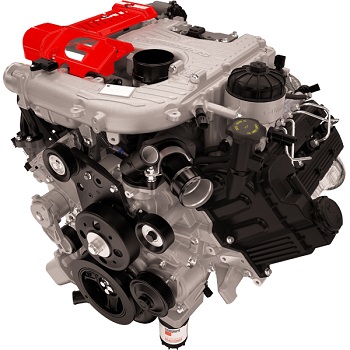
Exhibited at the 2015 North American International Auto Show in Detroit, Michigan, the Nissan Titan XD’s development can be traced back to August 2013 when both engine manufacturer Cummins and automaker Nissan Motors confirmed they had partnered to install a 5.0L Cummins turbodiesel to the Titan pickup truck platform. The 4-cylinder Cummins diesel engine was previously offered to FCA’s Ram Truck division, which turned down the engine in favor of a smaller, more fuel-efficient engine from Italian manufacturer VM Motori.
A fully boxed “ladder” frame is used to deliver sufficient structural integrity for the Titan’s tow ratings, which surpasses 12,000 lbs. on adequately equipped trucks. The core of the Nissan XD is Cummins’ 5.0L V-8, which generates a maximum of 310 horsepower and 555 lb./ft of torque.
The Cummins 5.0L stands out from other diesel engines used in pickup trucks for its unique 90-degree V-8 design. Its CGI block and aluminum alloy cylinder ensure a durable yet lightweight foundation. Additionally, with the Cummins 5.0L, you will experience less noise, vibration, and harshness (NVH).
- Aspiration: Turbocharged and intercooler;
- Block material: Compacted Graphite Iron or CGI;
- Bore x Stroke: 70 x 3.54 inches;
- Cylinder head: Aluminum alloy;
- Displacement: 0L;
- Engine oil capacity: 10 Quarts /w Filter;
- Engine weight: 889 lbs.;
- Layout: V-8;
- Power: 310 hp;
- Torque: 555 lb./ft;
- Transmission: Aisin 6-Speed Automatic;
- Valvetrain: DOHC with 4 valves per cylinder.
9. 6.6L Duramax LML

The LML Duramax debuted in 2011 model Chevrolet HD and General Motors trucks. The latest variant of the 6.6L Duramax needs advanced emissions equipment, including the use of diesel exhaust fluid injection, to minimize nitrogen oxide emission levels by 63% over LMM-powered trucks. It enables this 4-cylinder diesel to exceed currently mandated federal emissions requirements and potentially meet future needs, too.
Rated at 765 lb./ft of torque and 397 hp, the LML is significantly more potent than any prior Duramax. GM blindsided Ford with the release of these numbers, which were exposed shortly after Ford’s 6.7L Power Stroke became available.
- Aspiration: Turbocharged and intercooler;
- Block material: Cast Iron Block;
- Bore x Stroke: 03 x 3.90 inches;
- Cylinder head: Aluminum;
- Displacement: 6L;
- Engine oil capacity: 10 Quarts with Filter or 9.5 Liters;
- Engine weight: 889 lbs.;
- Layout: V-8;
- Power: 397 hp;
- Torque: 765 lb./ft;
- Transmission: 6-Speed Allison Transmission;
- Valvetrain: OHV with 4 valves per cylinder.
10. 6.4L Power Stroke
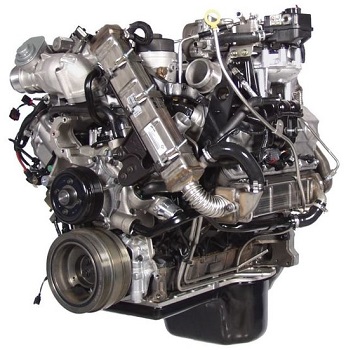
The 6.4L Power Stroke was introduced for the 2008 model Ford Super Duty trucks. Strict emissions regulations and the overall questionable dependability of the 6.0L were x-factors that demonstrated a need for a new, fresh engine design. Cleaner and quieter than its predecessors, the 6.4L Power Stroke was the first engine introduced to the market that used twin turbochargers from the factory and stayed the only engine to have such a turbocharger arrangement.
This’s also the first Power Stroke that utilizes a DPF to eliminate particulate emissions. The new DPF and active regeneration system hugely hindered the engine’s fuel economy capability. However, the 6.4L Power Stroke has proved to be comparatively reliable and strong.
The 6.4L Power Stroke uses an OHV design and powdered steel connecting rods capable of handling almost 1,000 horsepower.
- Aspiration: Turbocharged, twin sequential turbochargers, intercooler;
- Block material: Cast Iron;
- Bore x Stroke: 87 x 4.13 inches;
- Cylinder head: Cast iron;
- Displacement: 4L;
- Engine oil capacity: 15 quarts /w filter;
- Engine weight: 1,130 lbs.;
- Layout: V-8;
- Power: 350 hp;
- Torque: 650 lb./ft;
- Transmission: 5-Speed Automatic TorqShift transmission;
- Valvetrain: OHV 32 Valve.
Powerstroke vs. Cummins vs. Duramax Reliability
What sets the Powerstroke, Duramax, and Cummins diesel engines apart from each other? How did these 3 most reliable diesel engines become some of the greatest components of machinery ever produced?
While the 6.7L Power Stroke and 6.7L Cummins share the same displacement, the 6.6L Duramax is a pretty close match. Both the 6.7L Power Stroke and 6.6L Duramax are V8 engines, with the 6.7L Cummins being an inline six-cylinder diesel engine.
Horsepower and torque numbers are similar between the three diesel engines, but the Cummins engine leads the pack with its torque rating breaching the four-figure threshold. Other differences include engine cylinder and blockhead construction, bore and stroke, the compression ratio along with the firing order. Still, they share similar fuel systems.
Let’s take a look at the Cummins, Powerstroke, and Duramax best diesel engines.
| Specs | 6.7L Cummins Diesel I6 | 6.6L Duramax L5P V8 | 6.7L Power Stroke V8 |
| Displacement | 408 cubic inches, 6.7 liters | 403 cubic inches, 6.6 liters | 409 cubic inches, 6.7 liters |
| Configuration | I6 | V8 | V8 |
| Valvetrain | OHV – 24 valve, 4 per cylinder, solid lifter camshaft | OHV – 32 valve, 4 per cylinder, mechanical roller lifters | Pushrod OHV – 32 valves, 4 per cylinder, cam-in-block |
| Bore x Stroke | 4.21 x 4.88 inches | 4.055 x 3.897 inches | 3.90 x 4.25 inches |
| Firing Order | 1-5-3-6-2-4 | 1-2-7-8-4-5-6-3 | 1-3-7-2-6-5-4-8 |
| Compression Ratio | 16.2:1 | 16.0:1 | 16.2:1 |
| Horsepower | 400 horsepower | 445 horsepower | 450 horsepower |
| Torque | 1,000 lb./ft. | 910 lb./ft. | 935 lb./ft. |
| Fuel | Ultra-low sulfur diesel and B20 biodiesel | Ultra-low sulfur diesel and B20 biodiesel | Ultra-low sulfur diesel and B20 biodiesel |
| Engine Block | Compacted graphite iron | Cast Iron | Compacted graphite iron |
| Cylinder Heads | Cast Iron | Cast Aluminum | Aluminum |
| Fuel System | Direct injection with high-pressure common rail | Direct injection with high-pressure common rail | Direct injection with high-pressure common rail |
What is the Best Diesel Engine Ever Made?
The most reliable diesel engine ever made was the 5.9L Cummins 12-Valve 6BT. This unit has million-mile durability, and it arrived factory with 230 horsepower, 440 lb./ft of torque, and an inline P7100 injection pump. Diesel enthusiasts from the era of the 6BT could boost horsepower to over 500 horsepower with ease.
The engine had an outstanding performance and fuel efficiency rating. It’s almost guaranteed to last over 500k miles. Its fuel consumption rate was about 20 mpg on the highway.
